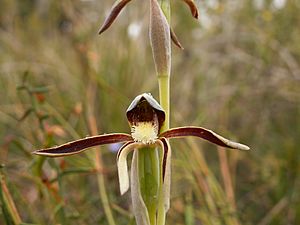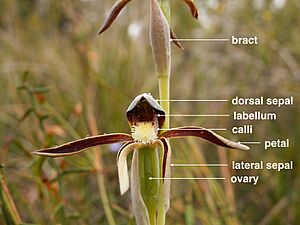Beak orchids facts for kids
Quick facts for kids Beak orchids |
|
|---|---|
 |
|
| Rattle beaks (L. serratus) | |
| Scientific classification |
|
| Kingdom: | Plantae |
| Clade: | Tracheophytes |
| Clade: | Angiosperms |
| Clade: | Monocots |
| Order: | Asparagales |
| Family: | Orchidaceae |
| Subfamily: | Orchidoideae |
| Tribe: | Diurideae |
| Subtribe: | Megastylidinae |
| Genus: | Lyperanthus R.Br. |
Lyperanthus, also known as beak orchids, are a type of flowering plant found only in Australia. They belong to the Orchid family, called Orchidaceae. There are two main kinds of beak orchids. One lives in Western Australia, and the other is found in four eastern Australian states. You can spot them by their single, long, tough leaf and their dull-colored flowers. These flowers have special bumps, called calli, on their lower lip (the labellum). Beak orchids often grow in groups. They can make new plants from their underground tubers or by making seeds from their flowers.
Contents
What Do Beak Orchids Look Like?
Beak orchids are plants that grow in the ground. They are perennial, meaning they live for more than two years, and deciduous, which means they lose their leaves at certain times. They have a few small roots and an oval-shaped tuber (a swollen underground stem, like a potato). Each year, new tubers grow from long, root-like stems called stolons.
Each plant has one upright, tough leaf that is 12 to 40 cm (5 to 16 in) long and 12 to 15 mm (0.5 to 0.6 in) wide. This leaf often has tiny bumps on its underside. It's usually the first part of the orchid you notice sticking out from other plants.
The flowers grow on a straight stem up to 50 cm (20 in) tall. Each stem can have one to eight flowers. The flowers are usually brownish, reddish, and green. Each flower has a special leaf-like part called a bract around its short stalk.
The top part of the flower, called the sepal, is about 2 cm (0.8 in) long and forms a hood over the center of the flower. The two side sepals are similar to the two petals. They are stiff, tough, and about 3 cm (1.2 in) long, often with their edges rolled inwards. The petals usually spread out, while the sepals hang down.
One petal is very different and is called the labellum. It's about 9 to 10 mm (0.35 to 0.39 in) long and gently curved. It has three parts, with the middle part surrounding the center of the flower. Most of the labellum is covered with rows of rounded or upright bumps called calli.
The parts of the flower that help it reproduce are joined together in a structure called the column, which is about 7 mm (0.3 in) long. Beak orchids bloom from August to November. After flowering, they produce a dry seed pod, called a capsule, which can hold up to 500 tiny seeds.
Naming the Beak Orchid
The group of plants called Lyperanthus was first officially described in 1810 by a botanist named Robert Brown. He wrote about it in his book Prodromus Florae Novae Hollandiae.
The name Lyperanthus comes from two Ancient Greek words: lypros, which means "poor" or "wretched," and anthos, which means "flower." This name was chosen because the flowers of these orchids have dull colors.
How Beak Orchids Live
Scientists don't fully know how the two types of Lyperanthus orchids are pollinated (how their pollen is moved from one flower to another). However, one species, L. suaveolens, smells very strong when the weather is warm. Both species also produce nectar, which is a sweet liquid. This suggests that bees might be their main pollinators.
Unlike many other orchid species in Western Australia, these orchids do not need a bushfire to happen before they will flower. They can bloom without fire.
Types of Beak Orchids
There are two main species (types) in the Lyperanthus group:
- Lyperanthus serratus – This one is called "rattle beaks" and is found in Western Australia.
- Lyperanthus suaveolens – This one is known as "brown beaks" and grows in New South Wales, Victoria, Queensland, and Tasmania.


